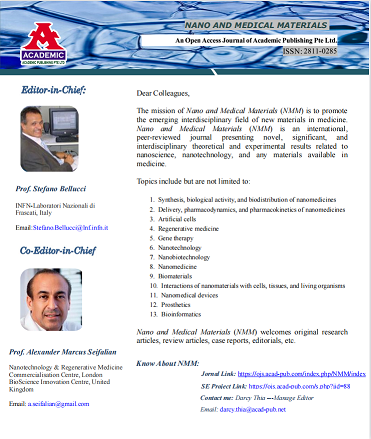
|
ISSN: 2811-0285 (Online) Journal Abbreviation: Nano. Med. Mater. Publication Frequency: The publication frequency of Nano and Medical Materials is bi-annual. Article Processing Charges (APC):Click here for more details Publishing Model: Open Access Submission to final decision: 68 days Acceptance to publication: 23 days |
About the Journal
The mission of Nano and Medical Materials (NMM) is to promote the emerging interdisciplinary field of new materials in medicine. Nano and Medical Materials (NMM) is an international, peer-reviewed journal presenting novel, significant, and interdisciplinary theoretical and experimental results related to nanoscience, nanotechnology, and any materials available in medicine. |
Announcements
Scholars are welcome to come to NMM to submit papers |
|
We are committed to making NMM a world-class journal, and we hope you scholars do not hesitate to share your knowledge and move forward with us! |
|
| Posted: 2023-09-07 | More... |
New Author Guidelines are updated |
|
Please follow the journal's author guideline and the required article template to prepare your manuscript. |
|
| Posted: 2023-09-06 | More... |
Prof. Alexander Marcus Seifalian Has Been Appointed as Co-Editor-in-Chief of Nano and Medical Materials |
|
Prof. Alexander Marcus Seifalian  Director/Professor of Nanotechnology & Regenerative Medicine |
|
| Posted: 2023-09-05 | More... |
| More Announcements... |
Vol 3, No 2 (2023) |
Table of Contents
|
Original Research Articles
by Parker Cole, Yang Tian, Savannah Thornburgh, Mary Malloy, Lauren Roeder, Micah Maulding, Yang Huang, Z. Ryan Tian
Nano. Med. Mater.
2023,
3(2), 249;
doi: 10.59400/nmm.v3i2.249
171 Views,
96 PDF Downloads
Investigations are underway to identify novel biomaterials to improve strategies for bone tissue engineering. Hybrid nanomaterials have emerged as a viable class of biomaterials. Here, we report a facile, economical, optimized, and well-controlled hydrothermal method for synthesizing Zr-doped potassium titanate nanofibers with high purity. Upon morphological characterization, Zr-doping did not disrupt the parent crystal structure of potassium titanate, which showed huge potential for bone tissue engineering.
|
|
Original Research Articles
by R. Biju
Nano. Med. Mater.
2023,
3(2), 261;
doi: 10.59400/nmm.v3i2.261
49 Views,
18 PDF Downloads
Copper-based nanocomposite has a wide variety of applications in various fields of science. The present study focuses on the preparation of copper oxide and zinc oxide nanocomposites by the chemical precipitation method. The prepared samples were analyzed with the help of various characterization techniques, such as XRD, SEM, UV/visible spectroscopy, and EDAX. Using the XRD pattern, the crystallite size determination is carried out, and the crystalline nature of the nanocomposite is confirmed. With SEM analysis, surface morphological studies were performed. EDAX analysis conforms to the formation of mixed metal oxide nanocomposites. The antimicrobial behavior of samples was evaluated for E. coli bacteria using the disc diffusion method. |
|
Review Articles
by Subhasri Mohapatra, Bhishm Kumar Sahu, Deepak Kumar Dash
Nano. Med. Mater.
2023,
3(2), 31;
doi: 10.59400/nmm.v3i2.31
153 Views,
71 PDF Downloads
According to studies made by previous researchers there are various technical problems associated with liposomes which can be avoided by designing colloidal drugs carrier like nanoparticles with nanotechnology. Now a days they are beneficial in the field of agriculture, veterinary, pharmaceutical, textile technologies. Site specific delivery of encapsulated drugs can be formulated with a nanometer size range which can be injected into the general circulation. The objective of this review is to explain the potential of NPs and nanotechnology associated with their characters and classifications, synthesis and application as the emerging scopes for NPs, rather will attract everyone’s attention. The aim of the present work is to characterize biodegradable nanoparticulate systems for oral controlled release, while numerous publications have appeared on this by international research teams, the research on polymeric nanoparticles has been primarily performed by a few research groups in Europe. Nanoparticles are being investigated as an alternative colloidal drug delivery system that could potentially avoid some of the technical problems observed with other drug delivery system. |
|
Review Articles
by Landon Dahle, Payal Vaswani, Dhiraj Bhatia
Nano. Med. Mater.
2023,
3(2), 151;
doi: 10.59400/nmm.v3i2.151
164 Views,
85 PDF Downloads
Tetrahedral DNA nanocages have emerged as highly versatile tools for delivering a wide range of biological agents by leveraging their unique structural properties and functional adaptability. This review critically examines the field of tetrahedral DNA nanocages as delivery agents, communicating key findings and insights from existing literature. An extensive examination of the advantages of tetrahedral DNA nanocages as drug-delivery vehicles is outlined, with specific emphasis on their exceptional cargo encapsulation efficiency and controlled release capabilities. An in-depth exploration of in vivo studies and preclinical models is provided, encompassing comprehensive assessments of therapeutic efficacy, pharmacokinetics, toxicity, safety, and targeting capabilities. Moreover, the potential of tetrahedral DNA nanocages in regenerative medicine applications is highlighted. To address future challenges and directions in the field, the review emphasizes the importance of optimization of large-scale synthesis and translational studies. The significant role of tetrahedral DNA nanocages as delivery agents is underscored, showcasing their potential to revolutionize the landscape of targeted and programmable therapeutic interventions. |
|
Review Articles
by Priyajit Chatterjee, Subhendu Dhibar
Nano. Med. Mater.
2023,
3(2), 220;
doi: 10.59400/nmm.v3i2.220
166 Views,
54 PDF Downloads
Nanotechnology has revolutionized the field of medicine, particularly in the development of novel drug delivery systems. Nanomaterial-based drug delivery systems offer several advantages over traditional methods, including enhanced therapeutic efficacy, improved bioavailability, targeted delivery, and reduced side effects. This review provides an overview of the applications and recent advancements in nanomaterial-based drug delivery systems. The first section of this review focuses on the different types of nanomaterials used in drug delivery, including liposomes, polymeric nanoparticles, dendrimers, carbon-based nanomaterials, and metallic nanoparticles. Each nanomaterial has unique physicochemical properties that can be tailored to optimize drug encapsulation, release, and targeting. The second section highlights the importance of nanoscale characterization techniques in evaluating the properties and performance of nanomaterial-based drug delivery systems. Characterization techniques such as dynamic light scattering, transmission electron microscopy, atomic force microscopy, and spectroscopic methods enable researchers to analyze particle size, morphology, surface charge, drug loading, and release kinetics. The third section discusses the application of nanomaterial-based drug delivery systems in various therapeutic areas, including cancer treatment, cardiovascular diseases, infectious diseases, and neurological disorders. These systems can be engineered to selectively accumulate at the target site, enhancing drug efficacy and minimizing off-target effects. The fourth section explores recent advancements in nanomaterial-based drug delivery systems, including stimulus-responsive and multifunctional nanocarriers. Stimuli-responsive systems can release drugs in response to specific triggers, such as changes in pH, temperature, or enzymatic activity, leading to site-specific drug release. Multifunctional nanocarriers combine drug delivery with diagnostic imaging, allowing real-time monitoring of drug distribution and therapeutic response. The final section addresses the challenges and future perspectives in the field of nanomaterial-based drug delivery systems. Challenges include regulatory considerations, toxicity concerns, scalability, and clinical translation. Future directions involve the development of personalized nanomedicine, combination therapy approaches, and integration with other emerging technologies, such as artificial intelligence and gene editing. In conclusion, nanomaterial-based drug delivery systems have shown great potential for improving the efficacy and safety of therapeutic interventions. The advancements in nanotechnology offer exciting opportunities for the development of next-generation drug delivery platforms, opening new avenues for personalized medicine and targeted therapies. However, further research and collaborations are required to address the challenges associated with clinical translation and ensure the safe and effective implementation of these systems in clinical practice. |
|
Review Articles
by Sayali Aher, Afsar Pathan, Pankaj Jain, Shreyash Yadav, Eknath Ahire
Nano. Med. Mater.
2024,
3(2), 274;
doi: 10.59400/nmm.v3i2.274
95 Views,
41 PDF Downloads
As it is commonly recognized, the phenomenon of multidrug resistance (MDR) is increasingly prevalent on a global scale, posing significant challenges in the realm of treatment. MDR refers to a condition where resistance to various medications, which may differ in their chemical composition and mode of action, arises due to the presence of numerous mechanisms. In response to multidrug resistance (MDR), developing technologies in the field of nanotechnology, particularly Nanocarrier, are being utilized as counteractive measures. Nanocarrier refers to biodegradable materials that are employed in the field of drug delivery. Their primary function is to improve the solubility of medications that have low solubility, boosting their bioavailability. Additionally, nanocarriers enable the timed release of drugs and facilitate the accurate targeting of specific areas inside the body. Nanocarriers exhibit a diverse range of morphologies and dimensions, encompassing nanofibers, nanocomposites, nanoparticles, and nanotubes. These nanocarriers can be administered through injection, subcutaneous delivery, or intramuscular administration. In this review article, we focus on different nanocarriers and their use in MDR.
|
|
Perspectives
by Ravi Varala, Vijay Kotra, Anil Kumar Kanuri, Mahesh Reddy Burra, Shaik Nyamathullah
Nano. Med. Mater.
2023,
3(2), 244;
doi: 10.59400/nmm.v3i2.244
113 Views,
42 PDF Downloads
In many aspects, nanotechnology aids in the enhancement of the pharmacological and therapeutic qualities of traditional medications. Because nanocarriers can pass through the blood-brain barrier, they can be studied at the cellular level. Although nanodrug delivery has several drawbacks, it can adapt to minute alterations in the surrounding cellular environment, which helps to solve a lot of the present drug delivery issues. Strict standards should be developed by regulators to address their shortcomings. It is generally expected that during the coming years, nanotechnology will continue to advance and spread throughout many facets of science and life. The medical sciences will benefit from the applications of nanotechnology, which will include drug delivery systems, patient therapies, and diagnostic tools. Nanotechnology has been investigated thus far for targeted delivery and diagnosis. It is important to remember that the field of nanotechnology will only grow in the future in the healthcare industry. We provide some important insights about nanodrug delivery from this angle. |



